![]()
![]()
![]()
Use LEFT and RIGHT arrow keys to navigate between flashcards;
Use UP and DOWN arrow keys to flip the card;
H to show hint;
A reads text to speech;
69 Cards in this Set
- Front
- Back
|
What is Diabetes Mellitus? |
• Ametabolic disorder • Defective Insulin secretion/action/both • Effects include long-term organ dysfunction & failure |
|
|
When was the earliest known record of diabetes? |
1550BC |
|
|
What is the worldwide (Global Reporton Diabetes, WHO, 2016) for 1980? |
108 million diabetics (4.7%) |
|
|
What is the worldwide (Global Reporton Diabetes, WHO, 2016) for 2014? |
422 Million diabetics (8.5%) |
|
|
Name the current 7 countries with more than 10 million diabetics. |
• China • India • USA • Brazil • Russian Federation • Mexico • Indonesia |
|
|
How many people in the UK have diabetes? |
>1 in 16 people in UK have diabetes (diagnosed/undiagnosed)
• 3.5 million diagnosed diabetics
• 549000 people with undiagnosed diabetes
|
|
|
What is diabetes a minor cause of? |
• Blindness • Kidney failure • Heart attacks • Strokes • Limb amputation |
|
|
How much of the NHS budget is spent on diabetes? |
10% £10 billion |
|
|
What is the function of the pancreas? |
Dual function: • Exocrine- (95% tissue) • Endocrine |
|
|
What is the Exocrine function of the pancreas? |
Aids digestion-secretes enzymes digest proteins, fats & carbohydrates |
|
|
What is the endocrine function of the pancreas? |
• Regulates blood glucose • Islet cells release hormones in to blood stream |
|
|
What does insulin do? |
Lowers blood sugar |
|
|
What does glucogon do? |
Raises blood sugar |
|
|
What does somastatin do? |
Controls sugar/salt |
|
|
Name the cells in a pancreas? |
• Islets of Langerhans (<5%) • Alpha Cells (Glucagon,75%) • Beta Cells (Insulin, 20%) • Delta Cells (Somastatin, 5%) |
|
|
What is blood regulation essential for? |
For normal brain, kidney and liver function. |
|
|
Insulin release is stimulated by what? |
High blood glucose
• Muscles, red blood & fat cells absorbs glucose from the bloodstream
• decrease in Glucose |
|
|
What stimulates the release of glucagon? |
Low blood glucose
• Acts on liver to release glucose into blood stream
• Induces liver to synthesise glucose from other nutrients & breakdown ofenergy stores |
|
|
What is Glycogen? |
stored form of glucose (in muscles/liver) • Useful store of energy for exercise |
|
|
Glucagon release stimulates what? |
Glucagon release stimulates breakdown of Glycogen 》 Glucose |
|
|
What are the 2 types of Diabtes Mellitus? |
Insulin Deficiency (Type 1)
Insulin Resistance (Type2) |
|
|
What is type 1 diabetes? |
• Destruction of pancreatic Betacells • Depletion of insulin stores • Variable rate of cell destruction • Symptoms present when majority of cells are destroyed |
|
|
What is type 2 diabetes? |
• Inefficient response to Insulin (absorption) • Results in increased demand for insulin production • Increased insulin demand outweighs supply • Eventual impaired insulin production |
|
|
What is Hyper-glycaemia |
• High blood glucose (fasting blood glucose >7mmol/L |
|
|
What causes Hyper-glycaemia? |
• Absent/defective insulin
• >>Carbohydrates
• Missing diabetic medication/insulin dose
• Stress
• Poor health/infection |
|
|
What are the symptoms of Hyper-glycaemia? |
Inceased: • urination • thirst • fatigue • hunger |
|
|
What Is Hypo-glycaemia? |
Low blood glucose (<4mmol/L) |
|
|
What causes hypo-glycaemia? |
• >dose diabetic medication • Delayed meal, Exercise |
|
|
What are the symptoms of hypo-glycaemia? |
• Sweating, fatigue, dizzy • Pale, weak, hunger • Confusion, Convulsions ,Coma (extreme) |
|
|
What is Keto-acidosis? |
Very raised blood glucose (>15mmol/L T1>>>T2) |
|
|
What causes Keto-acidosis? |
• Missed insulin injections/faulty insulin pump or pen
• Infection, Alcohol, Drugs, extreme or prolonged stress
• Prior to T1 diagnosis |
|
|
What are the symptoms of Keto-acidosis? |
• Vomiting, Dehydration, Sweet smelling breath (peardrops)
• Hyperventilation, Tachycardia • Confusion, disorientation, Coma & Death |
|
|
Diabetes classification |
• Type 1- usually early onset (approx.10%) • Type 2- usually later onset (approx.90%) • Adults - 56% Males, 44% Females |
|
|
Describe Type 1 diabetes. |
• No association with body weight • Ketones may be present at diagnosis • Usually symptomatic • Requires insulin management • Cannot be prevented |
|
|
Describe Type 2 diabetes. |
• Often weight associated • High BP/cholesterol at diagnosis • May be asymptomatic • Maybe controlled with diet/medication, some may need insulin • Maybe prevented (education) |
|
|
What are the risk factors associated with type 1 diabetes? |
• Debated • Viral exposure • Geography (Northern climates) • Ethnicity (<China,>USA Caucasians) • Family history • Other auto-immune conditions |
|
|
What are the risk factors associated with type 2 diabetes? |
• Family history • Ethnicity, Age>40y/o • BMI>30, Poor diet • Smoking, Sedentary • Previous gestational diabetes or large baby • High BP/Cholesterol, Poly-Cystic Ovary Syndrome |
|
|
What is Gestational diabetes? |
• Diabetes in 2nd/3rd trimester (usually resolves post natal)
• Foetal growth demands increased insulin demand (2nd trimester) |
|
|
What are the risk factors of gestational diabetes? |
• Maternal obesity, Family history ofdiabetes • Previous history of gestational diabetes or large baby (>10lb) • Ethnicity: South Asian, African-Caribbean, Middle Eastern |
|
|
What drugs are used to treat diabetes? |
• Biguanides (e.g. Metformin)
• Sulphonylureas (e.g. Glicazide, Tolbutamide) |
|
|
What types of insulin are there? |
• Animal (<common) • Human (synthetic match) • Analogues (c. 1990’s) |
|
|
Speed of action of insulin? |
• Short/rapidacting: 0-5h • Long acting: back ground cover 12-24h • Ultra-long : up to 42 hours |
|
|
Name the 3 chronic complications associated with diabetes. |
Macro-vascular disease
Microvascular disease |
|
|
What is Macro-vascular disease? |
• a disease of any large (macro) blood vessels in the body.
• Increased risk of CVD, M.I & Stroke • Arterial wall chronic inflammation& damage • General atherosclerosis (arterial narrowing) • Lipid rich atheroma formation (prone to rupture) • Increased platelet adhesion 》vascular occlusion |
|
|
Name the 3 components of Microvascular disease? |
• Retinopathy (DiabetesII) • Neuropathy-nerve fibre damage from disrupted vascular supply • Nephropathy-changes in kidney structure affect function leading to leakage of proteins into urine |
|
|
What sensory neuropathy? |
• Reduced touch/temperature and pain sensation (tingling, numbness, burning shooting pains) • Minor injuries may be ignored (e.g. progress to foot ulcers) |
|
|
What is autonomic neuropathy? |
Reduced supply to organs e.g. bladder, stomach |
|
|
What is motor neuropathy? |
Muscle weakness, wasting leg twitch, cramps. |
|
|
What is kidney disease Nephropathy? |
Slow destruction of small arteries involved in waste filtration.
Can affect both type 1&2 |
|
|
What are the signs and symptoms for kidney disease Nephropathy? |
• Swollen feet/ankles, Dark urine • Breathlessness, Fatigue, Nausea, vomiting |
|
|
How to control/manage kidney disease Nephropathy? |
Early stages: • Diet, exercise • Tight diabetic & BP control • ACE inhibitors - protect kidney function and BP
Late/End stages: • Macro-albuminuria- indicates kidney failure • Kidney dialysis / transplant |
|
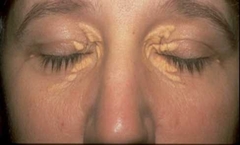
What is this? |
Xanthelasma |
|
|
What is Xanthelasma? |
• Assymptomatic • Yellow plaque • Usually superior lid • Altered and elevated lipid metabolism • Poor diet • Poorly controlled diabetes |
|
|
How do you treat/manage Xanthelasma? |
• Refer for blood lipid profile • Cardiovascular work up • Cosmetic removal |
|
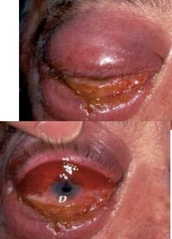
What is this? |
Orbital Mucormycosis |
|
|
What is Orbital Mucormycosis? |
• Fungal infection of facial sinus/orbit • Associated with poor diabetic control & ketoacidosis • Rare/fatal condition • Immediate referral |
|
|
What are the corneal manifestations of diabetes? |
• Slow wound healing- Recurrent corneal erosions
• Corneal hypo-anaesthesia- sensory neuropathy
• >Dry eye- neuropathy &/or vascular changes to lacrimal gland • Descemet’s membrane- vertical wrinkles may present prior to Type 2 diagnosis
• Impact on contact lens wear |
|
|
What are the ciliary body and iris issues with diabetes? |
• Uveitis • Iris pigment epithelial loss |
|
|
What can happen to he rx with px with diabetes? |
• Myopia is greater in diabetics- possible increased lens thickness
• Fluctuating refractive error- poorly controlled glucose levels
|
|
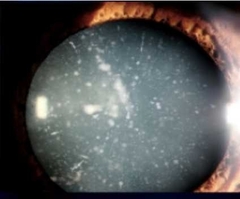
What is this? |
Cataracts in diabetics
Bilateral ‘Snowflake’ opacities |
|
|
Cataracts in diabetics. |
• Significantly > risk in diabetics but presents at earlier age
• Appears as normal cataract in diabetics, faster progression
• >Cortical changes |
|
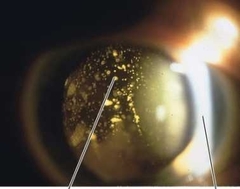
What is this? |
Vitreous-Asteroid Hyalosis |
|
|
What is Vitreous-Asteroid Hyalosis? |
• Small white / yellow ‘shiny’ vitreous opacities • Ca2+ & phosphate deposits
>Prevalence in diabetics & high BP/Cholesterol |
|
|
What causes Primary Open Angle Glaucoma diabetic px's? |
• Microvascular damage impairs blood flow to anterior optic nerve • Raised BP affects vascular perfusion of optic nerve • >IOP sensitivity compared to non-diabetics • Diabetics show> severe field loss |
|
|
What causes Primary Angle Closure Glaucoma in diabetics? |
• <common • Increased lens thickness (sorbitol overload) • Neuropathy of pupil nerves • Usually highly symptomatic • AC angle & IOP check essential • Acute attacks will require immediate referral |
|
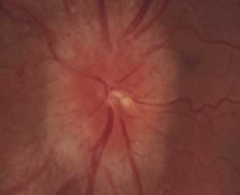
What is this? |
Diabetic papillopathy
• Rare, Unilateral/Bilateral • Can affect type 1& 2 • No proven link with diabetic control • Assymptomatic 》mild VA loss (slow progression) |
|
|
Name the non-retinal ocular manifestations of diabetes. |
• Xanthelasma • Orbital Mucormycosis • Cornea, ciliary body and iris issues • Refractive shift: - sustained changes - transient changes
• Cataracts- snowflake, getting them earlier • Vitreous asteroid Hyalosis- higher prevalence • Primary Open Angle Glaucoma • Primary Angle Closure Glaucoma • Diabetic papillopathy • III N Palsy • VI N Palsy |
|
|
What is III N Palsy? |
• Microvascular ischaemia • Eye is ‘down & out’ • Ptosis (may mask diplopia) • Pain (unknown origin) • Majority ‘pupil sparing’ • Spontaneous recovery by 3/12 |
|
|
What is VI N Palsy? |
• Defective lateral rectus • Affected eye cannot abduct • Horizontal diplopia |

